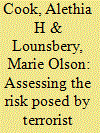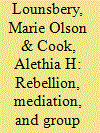| Srl | Item |
| 1 |
ID:
109140


|
|
|
|
|
| Publication |
2011.
|
| Summary/Abstract |
While terrorist organizations have been analyzed for their motivations and tactics, little has been done to develop a systematic understanding of what makes some groups more dangerous than others. Knowing what makes some groups more threatening than others, or what conditions can influence a single group to become more or less of a threat, would help governments to prioritize resources during counterterrorism efforts. Using an approach similar to Ted Robert Gurr's assignment of a risk score to identify impending minority group rebellion, this article develops and tests a set of terrorist organizational characteristics. A two-phased approach is used. First, the authors identify key characteristics that could be anticipated to drive groups to be more active or deadly. The characteristics were identified and measured for terrorist groups for 1990-1994. The authors test group characteristics against subsequent group violence intensity from 1995 to 1999. Findings indicate that some group characteristics, such as religious ideology and group size, are important to understanding a group's relative level of violence. Though the study focused on a relatively short period of time, the findings indicate that a more comprehensive study of the impact that group characteristics have on violence levels would be a worthwhile undertaking.
|
|
|
|
|
|
|
|
|
|
|
|
|
|
|
|
| 2 |
ID:
102510


|
|
|
|
|
| Publication |
2011.
|
| Summary/Abstract |
Multilateral and diplomatic resolutions to intrastate conflicts are the preferred method of termination. However, mediated settlements tend toward failure and conflict recurrence. A significant factor in this failure is that government and groups are heterogeneous. While the demands, goals, preferences, and intentions of both sides are sometimes viewed as being held in common, they are potentially as diverse as the groups' members. Understanding the relationship between resolution efforts and group heterogeneity is complicated but crucial to improving mediation success. The current article examines all intrastate conflicts for the period 1945-1999, in order to test two competing propositions found in the literature on group change and the occurrence of mediation. The primary question of interest is whether group change tends to result from or precede mediation attempts. In other words, is group change an impetus to engage in mediation or do mediation processes tend to result in altered group characteristics. The findings support only the proposition that when governments engage rebels in mediation, rebel group changes are significantly more likely to occur than without mediation. The implications of the findings are also discussed.
|
|
|
|
|
|
|
|
|
|
|
|
|
|
|
|